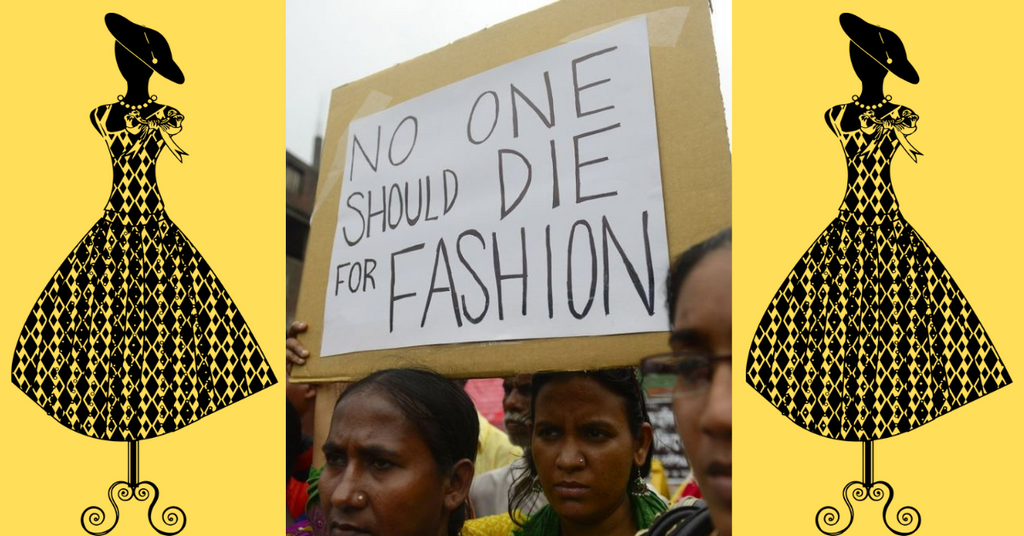Fast Fashion

I’m no stranger to sustainability. I buy second-hand clothes, I recycle and compost, and the company I co-own has used recycled / recyclable packaging since its inception. But I must admit it was my sister (and business partner) who led the charge when it came to sustainability in our business which, honestly, was occasionally viewed by me as an annoying barrier to my ability to purchase stretchy fabric with the proper elasticity. I also had some fear issues around Spandex suddenly becoming socially unacceptable – catastrophic for a lingerie designer.
Then I watched the documentary film, RiverBlue, and everything changed.

“There is a joke in China that you can tell the ‘it’ color of the season by looking at the color of the rivers.”
The quote comes from the opening scene of RiverBlue. It’s a devastating statement and what you hear as you watch footage of deep magenta wastewater spilling into a river. The movie continues with scene after scene of horrific pollution and statistic after statistic of the human suffering it causes. This film makes it graphically and overwhelmingly clear that the West’s demand for fast fashion has taken an enormous toll – on our planet and its people.
For example, it’s estimated that 70% of China’s rivers and lakes are contaminated by 2.5 billion gallons of wastewater produced by the textile industry. 2.5 BILLION GALLONS. That’s just one example and doesn’t even touch the fact that real people – men, women and children – depend on rivers in their everyday lives. People in other parts of the world interact with their rivers differently than we do here – some are even considered sacred. People swim in the rivers. People drink from the rivers.
I won’t come close to describing the enormity of the problem in this blog. But here’s what Sunita Narain, director general of the Center for Science and the Environment in India, said:
“We are committing hydrocide. We are deliberately murdering our rivers.”
Unfortunately, the devastation and heartache caused by fast fashion, does not end at the river’s edge. There’s also tons of textile waste generated every year. It's an overwhelming mountain of a problem. According to the Environmental Protection Agency, 11.2 million tons of textile waste ended up in landfills in 2017. And 84% of clothing ends up in landfills or incinerators. Americans actually discard 14 million tons of clothing a year – a number that has doubled over the last 20. And it’s important to note that once in the landfill, textiles can take up to 200 years to decompose.
Fashion Needs Human Hands
Fast fashion requires low wages for garment workers and weak environmental regulations - like they have in faraway places like China, Indonesia and Bangladesh. It also requires demand, like we have right here in the United States. Garment workers make the clothes that we buy – and about 80% of them are women. There are maddening, sensational examples of preventable tragedies involving garment workers. Rana Plaza collapsed in Bangladesh killing well over a thousand people in 2013. Just a year before, there were two tragic factory fires – one in Bangladesh and one in Pakistan – killing more than 400 workers, collectively. However, you only have to go as far as the United States to find garment workers who are not being protected by employment laws – including fair wages and decent working conditions. All in the name of fast fashion.
It’s All About the Benjamins
Fact: It’s cheaper to make clothes overseas and the more you make, the cheaper it gets. Much of the industry purposely overproduces and encourages trends that promote short fashion lifespans. So it’s a never-ending cycle of restocking an already overstocked warehouse. One of the consequences is racks of inexpensive pieces that have distorted our understanding of the real cost of making clothes.
Fact: We’ve all seen them hanging on retail racks, but you simply can’t make a woman’s blouse for 20 bucks in the U.S. legally. If you're a small brand dealing in minimum quantities, you can’t even come close.
What About Solutions?
The fashion industry is starting to move in the direction of addressing sustainability in meaningful ways. But it’s a huge, global issue that will require changes on the supply side and on the demand side. In other words, the industry has major changes to make in the way we create and deliver fashion and as consumers we must begin to make choices based on the real cost of the clothes we buy - the cost to us as well as to garment workers and the environment.
Destination Sustainability
At Activ Intimates, sustainability informs every step of our design process. Even before pencil is put to paper and throughout the process, we consider the pattern, construction, supply chain, production, waste, packaging, inventory and distribution through the lens of sustainability. We’re dedicated to discovering new ways to create lingerie without hurting the planet or anyone living on it. Not to say that we’ve arrived. But we've begun our journey and we're committed to staying on the path to full sustainability.
As for me, am I secretly praying that a textile engineer is hard at work developing patent leather fabric with a stretch that is 100% sustainable? Yes. I’ll take 20 yards in black.




Leave a comment